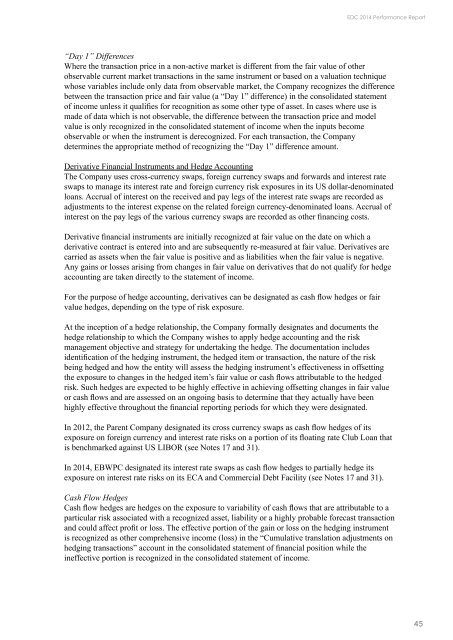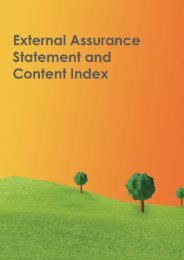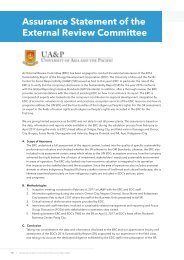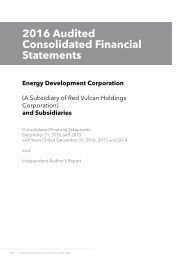2014 Financial Statement
Create successful ePaper yourself
Turn your PDF publications into a flip-book with our unique Google optimized e-Paper software.
EDC <strong>2014</strong> Performance Report<br />
“Day 1” Differences<br />
Where the transaction price in a non-active market is different from the fair value of other<br />
observable current market transactions in the same instrument or based on a valuation technique<br />
whose variables include only data from observable market, the Company recognizes the difference<br />
between the transaction price and fair value (a “Day 1” difference) in the consolidated statement<br />
of income unless it qualifies for recognition as some other type of asset. In cases where use is<br />
made of data which is not observable, the difference between the transaction price and model<br />
value is only recognized in the consolidated statement of income when the inputs become<br />
observable or when the instrument is derecognized. For each transaction, the Company<br />
determines the appropriate method of recognizing the “Day 1” difference amount.<br />
Derivative <strong>Financial</strong> Instruments and Hedge Accounting<br />
The Company uses cross-currency swaps, foreign currency swaps and forwards and interest rate<br />
swaps to manage its interest rate and foreign currency risk exposures in its US dollar-denominated<br />
loans. Accrual of interest on the received and pay legs of the interest rate swaps are recorded as<br />
adjustments to the interest expense on the related foreign currency-denominated loans. Accrual of<br />
interest on the pay legs of the various currency swaps are recorded as other financing costs.<br />
Derivative financial instruments are initially recognized at fair value on the date on which a<br />
derivative contract is entered into and are subsequently re-measured at fair value. Derivatives are<br />
carried as assets when the fair value is positive and as liabilities when the fair value is negative.<br />
Any gains or losses arising from changes in fair value on derivatives that do not qualify for hedge<br />
accounting are taken directly to the statement of income.<br />
For the purpose of hedge accounting, derivatives can be designated as cash flow hedges or fair<br />
value hedges, depending on the type of risk exposure.<br />
At the inception of a hedge relationship, the Company formally designates and documents the<br />
hedge relationship to which the Company wishes to apply hedge accounting and the risk<br />
management objective and strategy for undertaking the hedge. The documentation includes<br />
identification of the hedging instrument, the hedged item or transaction, the nature of the risk<br />
being hedged and how the entity will assess the hedging instrument’s effectiveness in offsetting<br />
the exposure to changes in the hedged item’s fair value or cash flows attributable to the hedged<br />
risk. Such hedges are expected to be highly effective in achieving offsetting changes in fair value<br />
or cash flows and are assessed on an ongoing basis to determine that they actually have been<br />
highly effective throughout the financial reporting periods for which they were designated.<br />
In 2012, the Parent Company designated its cross currency swaps as cash flow hedges of its<br />
exposure on foreign currency and interest rate risks on a portion of its floating rate Club Loan that<br />
is benchmarked against US LIBOR (see Notes 17 and 31).<br />
In <strong>2014</strong>, EBWPC designated its interest rate swaps as cash flow hedges to partially hedge its<br />
exposure on interest rate risks on its ECA and Commercial Debt Facility (see Notes 17 and 31).<br />
Cash Flow Hedges<br />
Cash flow hedges are hedges on the exposure to variability of cash flows that are attributable to a<br />
particular risk associated with a recognized asset, liability or a highly probable forecast transaction<br />
and could affect profit or loss. The effective portion of the gain or loss on the hedging instrument<br />
is recognized as other comprehensive income (loss) in the “Cumulative translation adjustments on<br />
hedging transactions” account in the consolidated statement of financial position while the<br />
ineffective portion is recognized in the consolidated statement of income.<br />
45
















